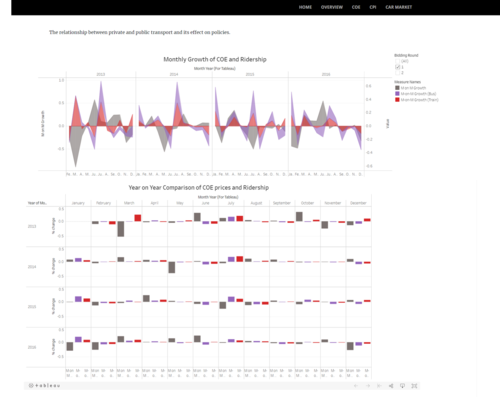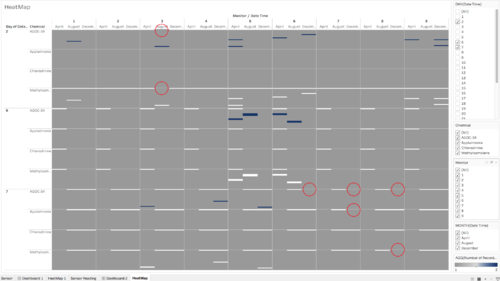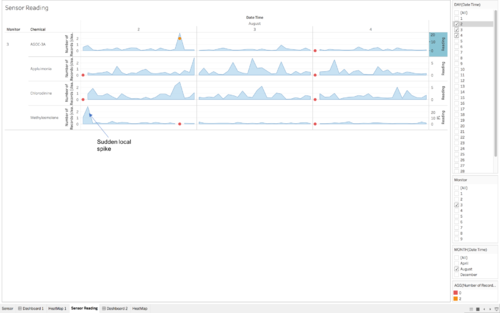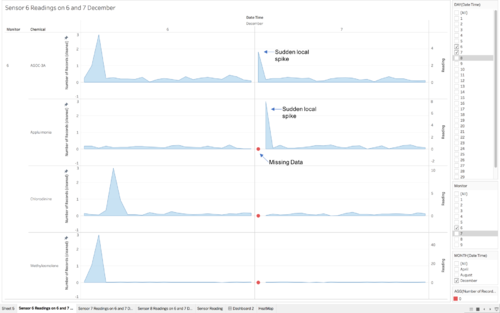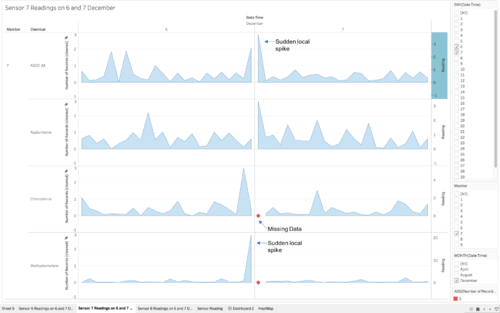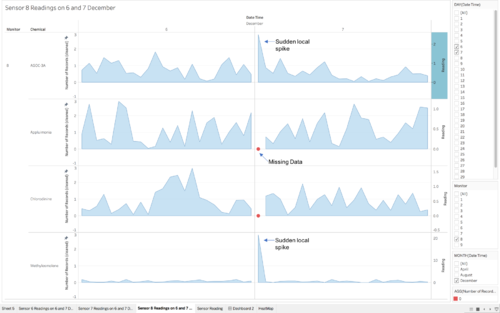IS428 2017-18 T1 Assign Benedict Wee Yu Rui
Contents
- 1 Links
- 1.1 The Task
- 1.2 Background Information
- 1.3 The Data
- 1.4 The Specific Tasks
- 1.4.1 Question 1: Characterize the sensors’ performance and operation. Are they all working properly at all times? Can you detect any unexpected behaviors of the sensors through analyzing the readings they capture?
- 1.4.2 Missing Midnight Values
- 1.4.3 Exception Cases
- 1.4.4 Question 2: Now turn your attention to the chemicals themselves. Which chemicals are being detected by the sensor group? What patterns of chemical releases do you see, as being reported in the data?
Links
The Task
General Task
The four factories in the industrial area are subjected to higher-than-usual environmental assessment, due to their proximity to both the city and the preserve. Gaseous effluent data from several sampling stations has been collected over several months, along with meteorological data (wind speed and direction), that could help Mitch understand what impact these factories may be having on the Rose-Crested Blue Pipit. These factories are supposed to be quite compliant with recent years’ environmental regulations, but Mitch has his doubts that the actual data has been closely reviewed. Could visual analytics help him understand the real situation?
The primary job for Mitch is to determine which (if any) of the factories may be contributing to the problems of the Rose-crested Blue Pipit. Often, air sampling analysis deals with a single chemical being emitted by a single factory. In this case, though, there are four factories, potentially each emitting four chemicals, being monitored by nine different sensors. Further, some chemicals being emitted are more hazardous than others. Your task, as supported by visual analytics that you apply, is to detangle the data to help Mitch determine where problems may be. Use visual analytics to analyze the available data and develop responses to the questions below.
The Specific Tasks
- Characterize the sensors’ performance and operation. Are they all working properly at all times? Can you detect any unexpected behaviors of the sensors through analyzing the readings they capture?Limit your response to no more than 9 images and 1000 words.
- Now turn your attention to the chemicals themselves. Which chemicals are being detected by the sensor group? What patterns of chemical releases do you see, as being reported in the data? Limit your response to no more than 6 images and 500 words.
- Which factories are responsible for which chemical releases? Carefully describe how you determined this using all the data you have available. For the factories you identified, describe any observed patterns of operation revealed in the data. Limit your response to no more than 8 images and 1000 words.
Background Information
The four manufacturing factories south of the nature preserve which Mitch is suspicious of the chemical releases and these are their coordinates:
| Factory | X | Y |
|---|---|---|
| Roadrunner Fitness Electronics | 89 | 27 |
| Kasios Office FurnituExample | 90 | 21 |
| Radiance ColourTeExample | 109 | 26 |
| Indigo SoExample ardExample | 120 | 22 |
In addition, these are the chemicals detected by the sensors and their following descriptions are below:
- AGOC-3A – New environmental regulations, and consumer demand, have led to the development of low-VOC and zero-VOC solvents. Most manufacturers now use one or more low-VOC substances and Mistford’s plants have wholeheartedly signed on. These new solvents, including AGOC-3A, are less harmful to human and environmental health.
- Appluimonia – An airborne odor is caused by a substance in the air that you can smell. Odors, or smells, can be either pleasant or unpleasant. In general, most substances that cause odors in the outdoor air are not at levels that can cause serious injury, long-term health effects, or death to humans or animals. However, odors may affect your quality of life and sense of well-being. Several odor-producing substances, including Appluimonia, are monitored under this program.
- Chlorodinine – Corrosives are materials that can attack and chemically destroy exposed body tissues. Corrosives can also damage or even destroy metal. They begin to cause damage as soon as they touch the skin, eyes, respiratory tract, digestive tract, or the metal. They might be hazardous in other ways too, depending on the particular corrosive material. An example is the chemical Chlorodinine. It has been used as a disinfectant and sterilizing agent as well as other uses. It is harmful if inhaled or swallowed.
- Methylosmolene – This is a trade name for a family of volatile organic solvents. After the publication of several studies documenting the toxic side effects of Methylosmolene in vertebrates, the chemical was strictly regulated in the manufacturing sector. Liquid forms of Methylosmolene are required by law to be chemically neutralized before disposal.
The Data
The data available consists of sensor readings from a set of air-sampling sensors and meteorological data from a weather station in proximity to the factories and sensors. The factories and sensors locations are provided in terms of x,y coordinates on a 200x200 grid, with (0,0) at the lower left hand corner (southwest). The sensors map shows the locations of the sensors and factories by number for the sensors and by name for the factories. The datasets given will go through some data cleaning in order to be visualized using Tableau:
- Sensor Data.xlsx
- Sensor Location.xlsx
- Meteorological Data.xlsx
The Specific Tasks
Question 1: Characterize the sensors’ performance and operation. Are they all working properly at all times? Can you detect any unexpected behaviors of the sensors through analyzing the readings they capture?
During the 3 month-long sample periods, 9 monitors are continuously measuring 4 chemical concentrations respectively. Sensor readings are logged at hourly interval 24 hours per day. Figure 1 shows an overview of the different sensors and its readings(9 sensors; 4 chemical detectors each; 3 month-long periods).
Missing Midnight Values
We can observe 2 patterns to the missing values represented by the white lines. The first pattern shows us that for certain timestamps there were missing data. Figure 2 shows that there are 7 points where there are records missing – Midnight on 2nd April, 6th April, 2nd August, 4th August, 7th August, 2nd December and 7th December. The readings show some exceptions cases (circled in red in Figure 2) were on the 2st August for Sensor 3 (AGOC-3A and Methylosmolene) and 7th December for Sensor 6 (AGOC-3A), Sensor 7 (AGOC-3A and Appluimonia), Sensor 8 (AGOC-3A)
There is a matching pattern which shows that the double-entry of AGOC-3A readings (in orange dots) coincides with the missing Methylosmolene readings (in red dots) as every double entry there will be a missing entry. It could probably that the readings were recording wrongly which may led to a huge spike of AGOC-3A readings.
Exception Cases
There are exception cases of data missing as some sensors data show rare spikes of chemical concentration readings. An example is On 2nd August missing data timestamp, Sensor 3 show a range of high readings of Methylosmolene. We can observe that there be probably show some affiliation between the consistent missing data and the possible unusual spike of chemical readings
On the midnight of 7 December of cases of missing data exception , it shows signs of spikes of Appluimonia (sensor 6, Figure 4), Methylosmolene and AGOC-3A (sensors 7 and 8, Figures 5 and 6).
